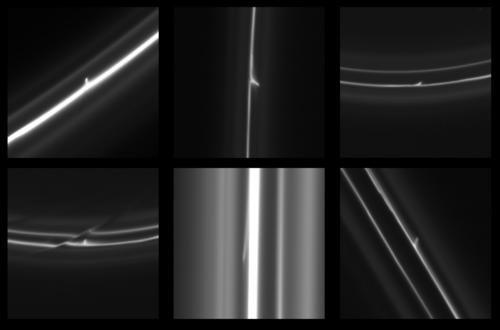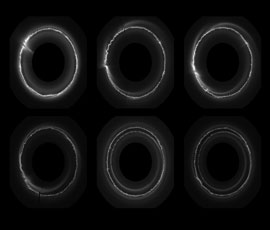Half-mile-sized objects have been seen punching through parts of Saturn's F ring, leaving glittering trails behind them. These mini-jets' trails in the rings fill in a missing link in our understanding of the curious behavior of the F ring.
Scientists have known that relatively large objects like the moon Prometheus, 92 miles across, can create channels, ripples and snowballs in the F ring but what happened to these snowballs after they were created was unclear.
Now Professor Carl Murray, Nick Attree, Nick Cooper and Gareth Williams from Queen Mary's Astronomy Unit have found evidence that some of the smaller snowballs survive, and their differing orbits mean they go on to strike through the F ring on their own. The small objects appear to collide with the F ring at gentle speeds – something on the order of about 4 mph (2 meters per second). The collisions drag glittering ice particles out of the F ring with them, leaving a trail 20 to 110 miles (40 to 180 kilometers) long.
Professor Murray's group happened to see a tiny trail in an image from 30 January 2009 and tracked it over eight hours. The long footage confirmed the small object originated in the F ring, so they went back through the Cassini image catalog to see if the phenomenon was frequent.
"The F ring has a circumference of 550,000 miles (881,000 kilometers) and these mini-jets are so tiny they took quite a bit of time and serendipity to find," said Nick Attree, a Cassini imaging associate at Queen Mary. "We combed through 20,000 images and were delighted to find 500 examples of these rogues during just the seven years Cassini has been at Saturn." 
This set of six images obtained by NASA's Cassini spacecraft shows trails that were dragged out from Saturn's F ring by objects about a half mile (1 kilometer) in diameter. Scientists have seen more than 500 of these kinds of trails in over 20,000 images collected by Cassini from 2004 to 2011. The trails seen in this set are typical of the entire collection. From left to right in the top row, the trails in these images are 18, 85 and 96 miles long (29, 136 and 155 kilometers long). In the bottom row from left to right, the trails are 43, 129 and 32 miles long (69, 207 and 51 kilometers long). Credit: NASA/JPL-Caltech/SSI/QMUL
The trails are also called "mini-jets" by Cassini scientists. Scientists believe they were originally formed by the pull of the moon Prometheus, which averages about 53 miles or 86 kilometers across, on tiny F ring particles.
In some cases, the objects traveled in packs, creating mini-jets that looked quite exotic, like the barb of a harpoon. Other new images show grand views of the entire F ring, showing the swirls and eddies that ripple around the ring from all the different kinds of objects moving through and around it.
Credit: NASA/JPL-Caltech/SSI/QMUL
Murray commented, "I think the F ring is Saturn's weirdest ring, and these latest Cassini results go to show how the F ring is even more dynamic than we ever thought. These findings show us that the F ring region is like a bustling zoo of objects from a half mile to moons like Prometheus a hundred miles in size, creating a spectacular show."
Linda Spilker, Cassini project scientist based at NASA's Jet Propulsion Laboratory, commented, "Beyond just showing us the strange beauty of the F ring, Cassini's studies of this ring help us understand the activity that occurs when solar systems evolve out of dusty disks that are similar to, but obviously much grander than, the disk we see around Saturn. We can't wait to see what else Cassini will show us in Saturn's rings."
Results presented today at the European Geosciences Union meeting in Vienna, Austria.






Comments